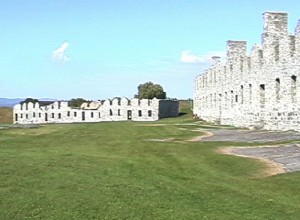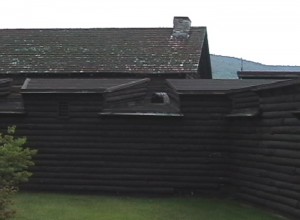Since the 1970s Ruth and I have occasionally vacationed in the Adirondack region of New York State. The area is rich in the history of the eighteenth-century conflicts between the French and English for dominance in North America. Last summer (in August 2008) we spent a week with our kayaks at a cottage in Chazy, New York, on Lake Champlain near the border with Canada. In the 1700s, that area was part of the major waterway passage running from Montreal and the St. Lawrence River down to New York City – a virtual straight line southward via the Richelieu River to Lake Champlain to Lake George to the Hudson River. This waterway became dotted with forts and battlefields that saw action in the French and Indian War (1754-1763) and the American Revolution (1775-1783).
In 2008 we saw the Fort Montgomery ruins at the north end of Lake Champlain as well as Valcour Island – the site of Benedict Arnold’s famous naval battle in the Revolutionary War. (Arnold’s fleet of small boats lost the battle, but the British advance down Lake Champlain was halted, buying precious time – a whole year – for the colonials to prepare for their victory at Saratoga.) This year we rented a cottage near Schroon (pronounced, “Skroon”) Lake for another week of kayaking. On August 19 we gave the kayaks a rest and drove about twenty miles to revisit Fort Ticonderoga on Lake Champlain. The original fort had been constructed by the French (1755-1759) and was called Fort Carillon. It was later renamed Ticonderoga under British control, and it played a very prominent role in both of the major North American wars of the eighteenth-century, but by 1800 the fort was in ruins. The present buildings were reconstructed beginning in 1908. All-in-all our day of history was well fortified. Tomorrow we”ll be kayaking on the Schroon River.
A Fortuitous Addendum – Saturday, August 23, 2009:
After kayaking on Eagle Lake in the morning we decided to drive 30-miles to visit the village of Lake George to see another eighteenth century fort – Fort William Henry which was reconstructed in the 1950s. This historic fort was made famous in James Fenimore Cooper’s “The Last of the Mohicans,” in which the story is told of Montcalm’s seige and victory over British Colonel George Munro in 1757. The four-pointed reconstruction of the fort is impressive with its horizontal wooden walls and numerous canon bays. We saw a young (highschool-aged) costumed drummer and a fifer, but we arrived too late to hear them perform. In spite of the fact that the reconstructed fort is at the identical site of the original, it is today engulfed in numerous tourist and commercial enterprises. Nevertheless, with a little imagination, the fort’s magnificent setting – at the foot of Lake George, with high, rolling tree-lined mountains crowning the shores looking northward – is very impressive.
All-in-all our day of history was well fortified. Tomorrow we”ll be kayaking on the Schroon River.
A Fortuitous Addendum – Saturday, August 23, 2009:
After kayaking on Eagle Lake in the morning we decided to drive 30-miles to visit the village of Lake George to see another eighteenth century fort – Fort William Henry which was reconstructed in the 1950s. This historic fort was made famous in James Fenimore Cooper’s “The Last of the Mohicans,” in which the story is told of Montcalm’s seige and victory over British Colonel George Munro in 1757. The four-pointed reconstruction of the fort is impressive with its horizontal wooden walls and numerous canon bays. We saw a young (highschool-aged) costumed drummer and a fifer, but we arrived too late to hear them perform. In spite of the fact that the reconstructed fort is at the identical site of the original, it is today engulfed in numerous tourist and commercial enterprises. Nevertheless, with a little imagination, the fort’s magnificent setting – at the foot of Lake George, with high, rolling tree-lined mountains crowning the shores looking northward – is very impressive.

